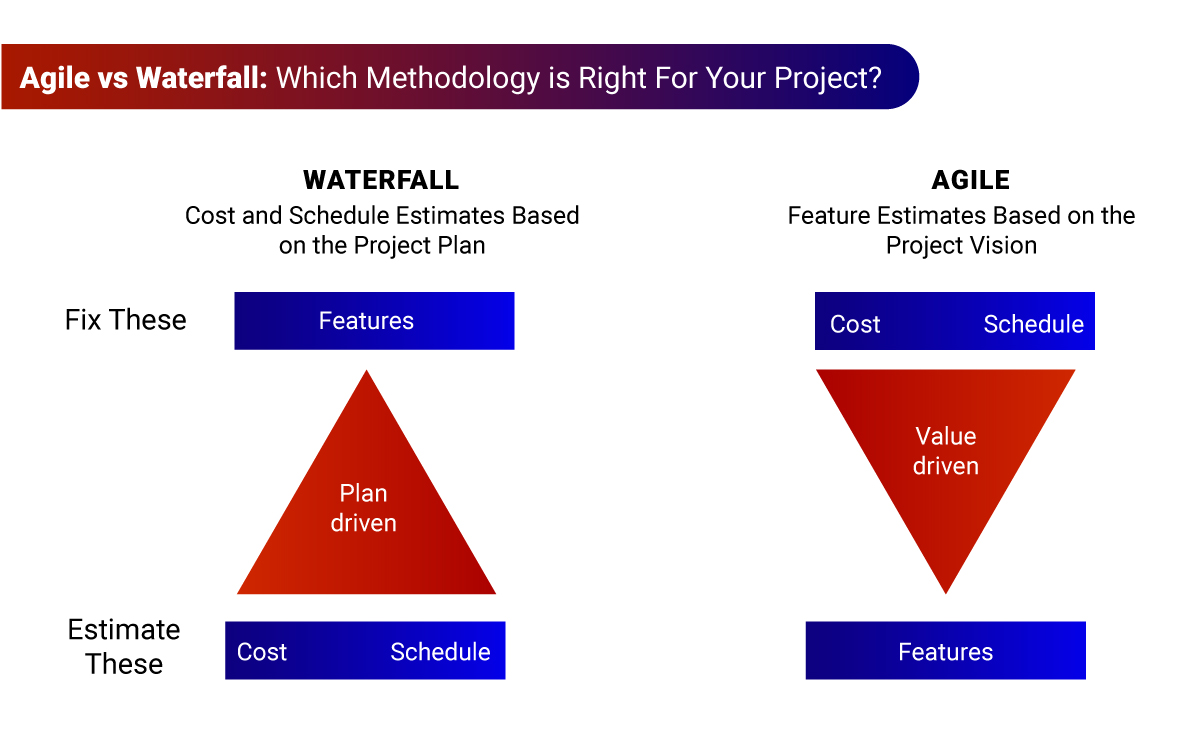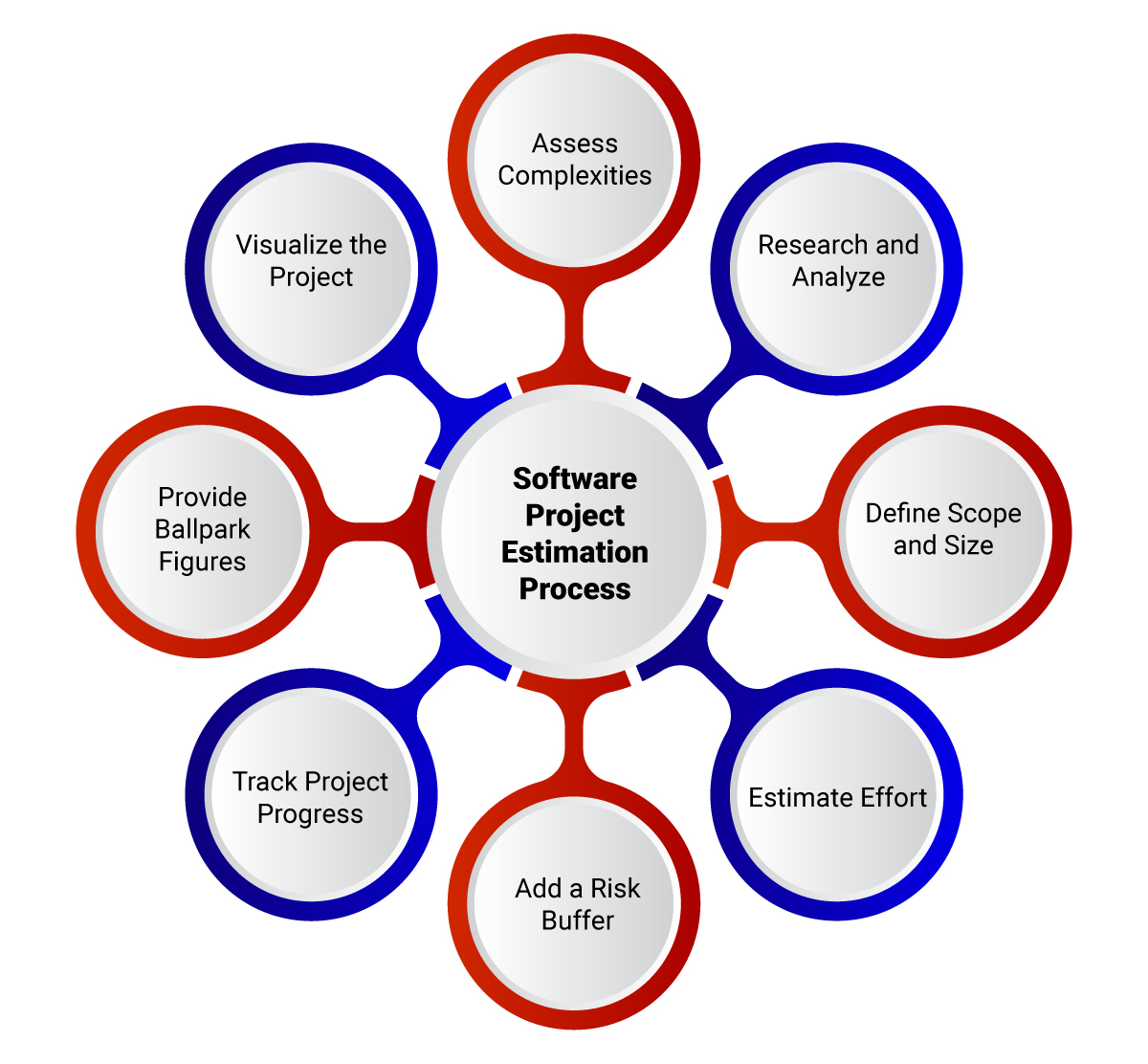The successful project starts with an accurate estimation that includes various project parameters such as project size, efforts required to develop the software, project duration, and cost. When starting a new software project, having a reliable project estimate can mean the difference between costly failure and profitable success.
Just the way meteorologists leverage trends and patterns to forecast weather conditions, project managers also need the right project estimation techniques and tools to plan, estimate, and navigate potential issues.
If you’re aiming to finish your project within schedule and budget, this blog about software project estimation tools and techniques is your go-to resource. Discover ways to precisely predict the project’s scope, budget, timeline, and ongoing resource requirements.
What are Software Project Estimation Techniques?
Project estimation techniques in software engineering are systematic methodologies that help you accurately forecast the budget, timeline, resources, and other variables crucial to achieving your project goals. This process involves determining the time frame for diverse tasks, the associated costs, and profit potential. A comprehensive evaluation enables key decision-makers to accurately estimate the viability of a project.
The project management methodology provides the overarching framework for selecting and applying the appropriate software estimation techniques.
There are two main project management methodologies: Agile and Waterfall. Agile Methodology is a flexible and iterative approach to project management. Waterfall Methodology is a traditional, linear, and structured project management methodology.
Each methodology serves a specific purpose, offering a tailored approach to meet unique project requirements. Choosing the right project management methodology or a combination is vital for effective project planning and successful execution.

Quantitative Estimation
In Agile Environments:
- Utilizes empirical data from iterative cycles.
- Enables adaptability to changing requirements during sprints.
In Waterfall Environments:
- Leverages concrete data for precise project planning.
- Best suited for projects with well-defined and stable requirements.
Qualitative Estimation
In Agile Environments:
- Draws on experiential insights for flexible planning.
- Particularly effective for dynamic projects with evolving scopes.
In Waterfall Environments:
- Incorporates subjective judgments to navigate uncertainties.
- Ideal for projects with a clear, sequential structure and known variables.
Now, let’s move to explore the major project estimation techniques used in Agile and Waterfall methodologies.
Types of Project Estimation Techniques
In both Waterfall and Agile methodologies, distinct project estimation techniques are employed to navigate the unique challenges posed by each approach.
Agile Project Estimation Techniques
Agile project management emphasizes adaptability and iterative development. Methods of project estimation techniques in Agile are often based on relative sizing and collaboration among team members.
#1. Story Points
Story Points in Agile involve estimating the complexity of user stories by assessing the effort required relative to other stories. It provides a quantifiable measure for the team to gauge the workload of each task.
Process:
- Team evaluates the complexity of user stories.
- Assigns story points based on perceived effort compared to a reference story.
Benefits:
- Offers a standardized way to measure and compare the complexity of user stories.
- Facilitates efficient workload management and resource allocation.
#2. Planning Poker
This is a collaborative Agile estimation technique where team members collectively estimate the effort required for specific task or user story. It promotes teamwork, discussion, and consensus in decision-making.
Process:
- Team uses Planning Poker cards with different numbers representing effort.
- Discusses estimates, aiming for a collective decision on task effort.
Benefits:
- Fosters collaboration and communication among team members.
- Ensures a more accurate and collective assessment of task complexities.
#3. T-Shirt Sizing
It employs relative sizing to estimate the size or complexity of user stories or tasks. Sizes are denoted by t-shirt sizes like Small, Medium, Large, and XL, offering a quick, high-level estimate during backlog grooming or sprint planning.
Process:
- Team members assign sizes based on perceived complexity relative to a reference story.
- Sizes: Small (easy), Medium (moderate), Large (complex), and XL (very complex).
Benefits:
- Simple and quick implementation for rough estimates during early project planning.
- Encourages team collaboration and discussion on the complexity of user stories.
- Facilitates a swift assessment of overall workload and capacity planning.
#4. Velocity
Velocity in Agile measures the amount of work that a team can complete in each sprint. It is calculated by summing up the story points of all the completed user stories in each sprint and dividing that by the number of days in the sprint. It helps teams predict future work based on historical performance, providing a valuable metric for planning.
Process:
- Team calculates the total effort completed in a sprint.
- Uses this historical data to forecast future work and set realistic expectations.
Benefits:
- Enables teams to understand their capacity and plan work for future sprints.
- Provides a quantitative metric for continuous improvement and planning.
#5. Three-Point Estimation
It involves assessing three scenarios: optimistic, pessimistic, and most likely. Each scenario yields a distinct estimate, and a weighted average is then calculated to determine the final estimate. This method mitigates uncertainties in project estimates, offering a more realistic assessment of the effort required for a task or user story.
Process:
- Optimistic Estimate: Best-case scenario assuming smooth progress.
- Pessimistic Estimate: Worst-case scenario considering potential obstacles.
- Most Likely Estimate: Realistic assessment based on the team’s experience.
Benefits:
- Provides an accurate estimate by considering various potential outcomes.
- Accounts for uncertainties, minimizing the impact of overly optimistic or conservative estimates.
Discover the power of agile pod delivery model and its impact on project delivery in this insightful blog on agile pod methodology.
Waterfall Project Estimation Techniques
Waterfall project management follows a sequential, linear approach to development. Estimation techniques for project management in Waterfall often involve detailed planning at the beginning of the project.
#1. Top-Down Estimation
In waterfall project management, a top-down approach involves starting with a high-level estimate for the entire project and then breaking down the project scope into smaller, separate components or phases. Top-Down Estimation derives estimates for the overall project based on this detailed breakdown.
Process:
- Team identifies major components of the project scope.
- Based on the breakdown, creates an overall project cost estimate.
Benefits:
- Offers a high-level overview for initial project planning.
- Facilitates early budgetary considerations.
# 2. Bottom-Up Estimation
In waterfall, bottom-up estimation involves granular estimation for individual tasks or activities. These detailed estimates are then aggregated to provide a comprehensive project estimate.
Process:
- Team estimates individual task or activity costs.
- Estimates are aggregated to determine the total project estimate.
Benefits:
- Provides detailed insight into task-level resource requirements.
- Enables a more accurate overall project estimate.
#3. Expert Judgment
The expert judgment estimation technique leverages the insights, knowledge, and intuition of experienced individuals or subject matter experts. The expertise of the client success team contributes to estimating various project parameters such as project costs, duration, and resource requirements.
Process:
- Team consults experienced members or subject matter experts.
- Leverages their insights to estimate project parameters.
Benefits:
- Team utilizes the wisdom of experienced members.
- This enhances the accuracy of project parameter estimates.
#4. Analogous Estimation
It is essentially a top-down estimation technique that compares the current project with similar projects completed in the past. Historical data is used to estimate the average cost, duration, and resource requirement of the current project, and it is particularly useful when relevant historical information is available.
Process:
- Team identifies similarities with past projects.
- Estimates the current project based on historical data.
Benefits:
- Leverages historical data for more accurate estimates.
- Streamlines estimation when past project comparisons are valid.
#5. What-If Analysis
Involves exploring different scenarios and their potential impact on project estimates. It helps assess the effects of changes in assumptions or constraints on the project plan.
Process:
- Team explores various scenarios impacting project estimates.
- Helps with assessing the effects of changes in assumptions or constraints.
Benefits:
- Enhances adaptability by considering multiple scenarios.
- Allows proactive assessment of potential impacts.
Why is Estimation Important for Software Projects?
Estimations make it easy to assess project cost and scope, resource allocation, proposal, and budget accuracy. It improves deadline forecasting, contributing to successful project delivery and enhanced communication with clients and stakeholders.
The key benefits of implementing proven estimation techniques in software development are:
- Gives a high-level overview of tasks and required resources for project completion
- Ensures precise proposal and budget development
- Improves project forecasting for better challenge anticipation
- Provides clarity for team members, contractors, and clients
- Considers various potential outcomes based on decision points
- Helps address and mitigate potential project risks
- Facilitates swift response to unexpected issues
- Mitigates risks by allocating extra time, budget, and resources
- Prevents deviations from deadlines and budget constraints.
These diverse benefits of effective project estimation are an outcome of the various types of estimations that occur throughout a project. So, let’s find out what aspects of a software project you need to estimate.
Software Project Estimation Checklist
There are five types of estimations that are crucial during a project. You can follow this software project estimation checklist to estimate these key areas for precise project planning, on-time delivery, and successful outcomes.
Budget
In software development, budget estimation involves calculating expenses such as licensing fees, developer salaries, and cloud service costs. This ensures financial transparency and effective allocation of funds.
Timeline
Timelines are crucially estimated, covering coding, testing, debugging, and deployment phases for efficient project planning estimation and on-time delivery.
Scope
Defining the project scope entails specifying all the work that must be done to finish the project. By estimating how much work is involved in the project, you can prevent scope creep and ensure you have the necessary materials and resources for the project.
Risk
Identifying risks, like compatibility issues and security vulnerabilities, allows you to plan mitigation strategies well in advance.
Resources
Resource estimation involves determining the required team members and infrastructure for optimized productivity throughout the development lifecycle.
Standard Process of Software Project Estimation
Without a clear understanding of project scope and complexity, software products can easily spiral into confusion, leading to missed deadlines, budget overruns, and dissatisfied stakeholders. To navigate these complexities of project estimation, it’s important to adopt a structured and methodical approach. Here’s a step-by-step framework to ensure accurate and reliable projections.

Assess the Project’s Complexities
- Understand client challenges and business goals.
- Gather information through online video calls and client-provided documents.
- Clarify aspects such as pain points, features, platforms, existing components, use cases, prioritization, tech stack, timeframe, and budget.
Research and Analyze
- Conduct meetings to discuss requirements, brainstorm ideas, and address questions.
- Outline the high-level architecture, tech stack recommendations, mockups, wireframes, team breakdown, and rough timelines.
Define Project Scope and Size
- Use the Work Breakdown Structure (WBS) to define the development stages and tasks.
- Meticulously define deliverables, functionalities, and requirements for a comprehensive scope statement.
Estimate Effort for Each Task
- Consider task complexity, historical data, and team expertise.
- Use estimation techniques (expert judgment, analogy estimation, parametric estimation).
- Sum up individual task effort estimates, considering dependencies.
- Apply estimation adjustment factors like team experience, tool availability, and external constraints.
Add a Risk Buffer
- Introduce a risk buffer of 5-25% of the overall project time based on project complexity.
- Mitigate common risks like integration issues, technology unpredictability, and team conflicts.
- Allocate at least 20% of the project time for unforeseen elements like team meetings, communication gaps, and productivity fluctuations.
Monitor and Track Project Progress
- Continuously monitor progress against initial estimates.
- Regularly communicate timelines and resource requirements.
- Periodically review and refine estimates as project details evolve.
Provide Ballpark Figures
- Before detailed time estimation, offer general predictions to set expectations.
- Based on software complexity, provide ballpark estimates using past experience or industry benchmarks.
- For instance, provide an estimate like “the project will take approximately 6 months for two teams of 6 people.”
Visualize the Project
- Utilize tools like Asana, Jira, Trello, and Azure DevOps for a hierarchical project structure.
- Follow WBS principles for hierarchy, the 100% rule, mutually exclusive elements, and an outcome-oriented focus.
Successful software project estimation requires a careful and systematic approach. By following the above steps, teams can assess scope, estimate effort, and ensure timely delivery, enhancing stakeholder satisfaction.
How Rishabh Software Can Help You Choose the Right Project Estimation Technique?
In 2023, only 35% of projects could be completed successfully, emphasizing the need for efficient project management driven by accurate estimation processes.[1]
Inaccuracies in estimates can put your client relationships at stake, resulting in financial losses, and even damage your professional reputation – a consequence that no company wants to face. That’s where our seasoned team at Rishabh Software can help you effectively assess your project scope, break down tasks, estimate effort, and refine estimations to reflect real-world conditions. Continuous monitoring and prompt communication will further enhance the accuracy and reliability of your project estimations.
Explore our comprehensive software product development services that have you covered, from user-centric analysis and innovative architectural choices to UI/UX designing, compliance mapping, and ongoing support.
Frequently Asked Questions
Q: When should project estimates take place?
A: Estimating projects is a crucial step in both traditional Waterfall and Agile approaches. In Waterfall projects, estimates are initially created during the planning phase after project initiation, with adjustments made as new information crops up. Agile projects are organized into iterations or sprints and so, they involve initial estimates during overall project backlog creation. Further estimations are crafted during each sprint, including retrospective and planning sessions.
Q: Who estimates software projects?
A: The responsibility for estimating projects lies with the project team, with the project manager overseeing the process and ensuring completion. Involving the entire team and subject matter experts is key to generating accurate and realistic estimates. Regular refinement ensures that project estimates align with project progress and changing circumstances.
Q: What are the popular software project estimation tools?
A: There are many popular software project estimation tools and techniques but listed below are 4 preferred tools that enhance our team’s efficiency and accuracy in project estimation processes:
- Asana – provides a user-friendly platform with features for task breakdown and timeline planning
- Jira – a robust tool that we use for agile project management to support task tracking, team collaboration, and project planning
- Trello – This visual collaboration tool simplifies project tracking with a user-friendly boards and cards system.
- Microsoft Project – This tool integrates comprehensive project management features, including estimation, along with the ability to create Gantt charts and monitor project progress.
Q: How can I improve the accuracy of estimation in project management?
A: For improving accuracy in project estimation, you need to tailor your approach to the project methodology. In Agile, accuracy is enhanced by continuous adaptation to changing requirements and frequent reassessment during iterations. Agile’s flexibility allows for real-time adjustments, reducing the impact of evolving project dynamics. On the other hand, Waterfall is advantageous in scenarios where project requirements are well-defined and stable from the start. Its structured nature ensures a detailed initial estimation, providing accuracy in projects where changes are minimal throughout the development process.
Footnotes:
1. https://hbr.org/2023/02/how-ai-will-transform-project-management











 30 Min
30 Min


